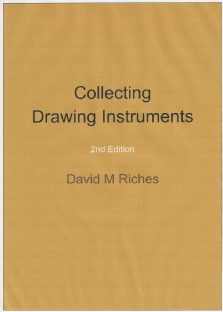



Drawing instruments form the largest part of my collection and I have interpreted the term widely; thus this section includes not only these but also related items used for navigation or calculation, including sectors and planimeters.
This section is divided into a number of subsidiary sections which can be accessed by pop up menus which appear when the button for drawing instruments is moved over with the cursor. However the section is so large that some of these sub-sections have had to be further sub-divided to yet another level, which can be accessed in a similar fashion.
The first three sub sections show examples of instruments from three periods which I have called “early”, “traditional” and “later”. These overlap widely and are characterised by style of instrument. “Early” instruments will generally be Georgian or earlier but may, in some cases be later where the style is from the early period. “Traditional” items will be to styles developed in the mid Victorian period although some of these continued to be made until after the second world war. “Later” instruments will be flat pattern, round pattern or other more modern styles, even though both the flat and round patterns were developed in the late nineteenth century. Do I hear you say “What a muddle”? Well I had to divide them up some way.
I have followed these sub-
The next sub-
The last sub-
Why not download my book on collecting drawing instruments? It is based on my own experiences and collection. It commences with a chapter describing the contents of a typical English, Victorian case and then continues with items from the Georgian period. Other drawing instruments are then considered in some detail in following chapters. Country characteristics are compared to assist identifying instruments and sets that do not have a maker’s name. This chapter is followed by one that considers the later forms of drawing instrument that supplanted and eventually replaced the traditional patterns in the 20th century. Unusual forms of instrument are then described before brief histories of some of the commonly found British, Continental and American makers. The last two chapters deal with building and caring for the collection. There is then a photo gallery followed by a glossary, references and index.
There are 180 pages, packed with information together with over 300 colour photographs. Above all the book is aimed at the average collector who, like myself, has a limited budget to spend.
The book can be seen and downloaded from the UK Slide Rule Circle website. Just follow the link and select it from the side-bar on the home page.

| Early Sets |
| Traditional Sets |
| Later Sets |
| Major Makers |
| Instruments |
| Miscellanea |
| W F Stanley |
| A G Thornton |
| W H Harling |
| Elliott Bros |
| J Halden |
| Riefler |
| E O Richter |
| Kern, Aarau |
| Keuffel & Esser |
| Compasses |
| Pocket compasses |
| Beam compasses |
| Dividers |
| Proportional dividers |
| Pens |
| Pencils |
| Rules |
| Protractors |
| Squares |
| Parallels |
| Pantographs |
| Sectors |
| Planimeters |
| Map Measurers |
| Miscellaneous |
| Materials Used |
| Who made them |
| Who made these |
| Addiator |
| Addimult |
| Other German |
| USA |
| Miscellaneous |
| Microscopes |
| Barometers |
| Hydrometers & Scales |
| Pedometers |
| Surveying Instruments |
| Other instruments |
| Workshop Measuring Tools |
| Catalogues & Brochures |
| Levels & Theodolites |
| Compasses & Clinometers |
| Miscellaneous surveying |
| Micrometers & Verniers |
| Engineering rules and gauges |
| Wood rules & calipers |
| Dial gauges & miscellaneous |